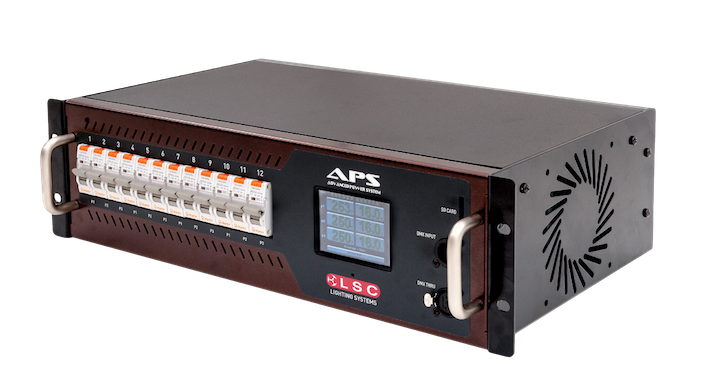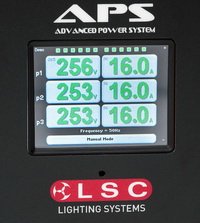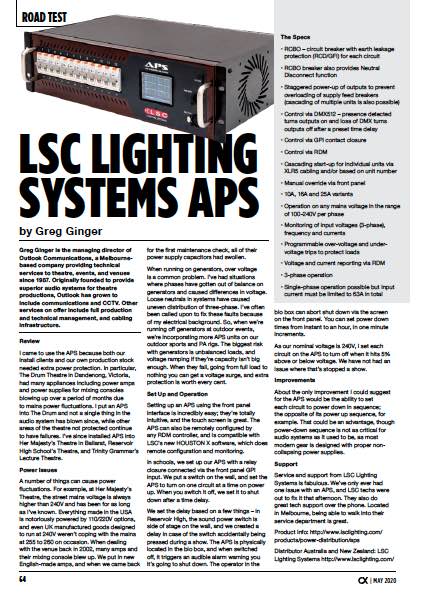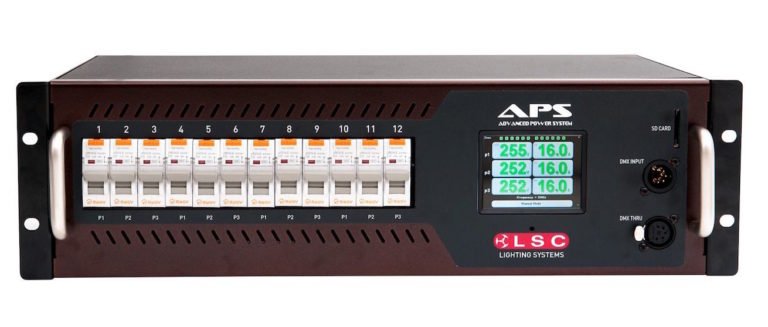News
21 May 2020
LSC Lighting Systems APS

Subscribe to CX E-News
Greg Ginger is the managing director of Outlook Communications, a Melbourne-based company providing technical services to theatre, events, and venues since 1987. Originally founded to provide superior audio systems for theatre productions, Outlook has grown to include communications and CCTV. Other services on offer include full production and technical management, and cabling infrastructure.
Review
I came to use the APS because both our install clients and our own production stock needed extra power protection.
In particular, The Drum Theatre in Dandenong, Victoria, had many appliances including power amps and power supplies for mixing consoles blowing up over a period of months due to mains power fluctuations.
I put an APS into The Drum and not a single thing in the audio system has blown since, while other areas of the theatre not protected continue to have failures.
I’ve since installed APS into Her Majesty’s Theatre in Ballarat, Reservoir High School’s Theatre, and Trinity Grammar’s Lecture Theatre.
Power Issues
A number of things can cause power fluctuations. For example, at Her Majesty’s Theatre, the street mains voltage is always higher than 240V and has been for as long as I’ve known.
Everything made in the USA is notoriously powered by 110/220V options, and even UK manufactured goods designed to run at 240V weren’t coping with the mains at 255 to 260 on occasion.
When dealing with the venue back in 2002, many amps and their mixing console blew up. We put in new English-made amps, and when we came back for the first maintenance check, all of their power supply capacitors had swollen.
When running on generators, over voltage is a common problem. I’ve had situations where phases have gotten out of balance on generators and caused differences in voltage. Loose neutrals in systems have caused uneven distribution of three-phase.
I’ve often been called upon to fix these faults because of my electrical background. So, when we’re running off generators at outdoor events, we’re incorporating more APS units on our outdoor sports and PA rigs.
The biggest risk with generators is unbalanced loads, and voltage ramping if they’re capacity isn’t big enough. When they fail, going from full load to nothing you can get a voltage surge, and extra protection is worth every cent.
Set Up and Operation
Setting up an APS using the front panel interface is incredibly easy; they’re totally intuitive, and the touch screen is great.
The APS can also be remotely configured by any RDM controller, and is compatible with LSC’s new HOUSTON X software, which does remote configuration and monitoring.
In schools, we set up our APS with a relay closure connected via the front panel GPI input. We put a switch on the wall, and set the APS to turn on one circuit at a time on power up.
When you switch it off, we set it to shut down after a time delay.
We set the delay based on a few things – in Reservoir High, the sound power switch is side of stage on the wall, and we created a delay in case of the switch accidentally being pressed during a show.
The APS is physically located in the bio box, and when switched off, it triggers an audible alarm warning you it’s going to shut down. The operator in the bio box can abort shut down via the screen on the front panel.
You can set power down times from instant to an hour, in one minute increments.
As our nominal voltage is 240V, I set each circuit on the APS to turn off when it hits 5% above or below voltage. We have not had an issue where that’s stopped a show.

Improvements
About the only improvement I could suggest for the APS would be the ability to set each circuit to power down in sequence; the opposite of its power up sequence, for example.
That could be an advantage, though power-down sequence is not as critical for audio systems as it used to be, as most modern gear is designed with proper non-collapsing power supplies.
Support
Service and support from LSC Lighting Systems is fabulous. We’ve only ever had one issue with an APS, and LSC techs were out to fix it that afternoon. They also do great tech support over the phone.
Located in Melbourne, being able to walk into their service department is great.
Product Info: http://www.lsclighting.com/products/power-distribution/aps
Distributor Australia and New Zealand: LSC Lighting Systems http://www.lsclighting.com
The Specs – LSC Lighting Systems APS
• RCBO – circuit breaker with earth leakage protection (RCD/GFI) for each circuit
• RCBO breaker also provides Neutral Disconnect function
• Staggered power-up of outputs to prevent overloading of supply feed breakers (cascading of multiple units is also possible)
• Control via DMX512 – presence detected turns outputs on and loss of DMX turns outputs off after a preset time delay
• Control via GPI contact closure
• Control via RDM
• Cascading start-up for individual units via XLR5 cabling and/or based on unit number
• Manual override via front panel
• 10A, 16A and 25A variants
• Operation on any mains voltage in the range of 100-240V per phase
• Monitoring of input voltages (3-phase), frequency and currents
• Programmable over-voltage and under-voltage trips to protect loads
• Voltage and current reporting via RDM
• 3-phase operation
• Single-phase operation possible but input current must be limited to 63A in total
CX Magazine – May 2020
LIGHTING | AUDIO | VIDEO | STAGING | INTEGRATION

Entertainment technology news and issues for Australia and New Zealand
– in print and free online www.cxnetwork.com.au
© VCS Creative Publishing
Subscribe
Published monthly since 1991, our famous AV industry magazine is free for download or pay for print. Subscribers also receive CX News, our free weekly email with the latest industry news and jobs.







